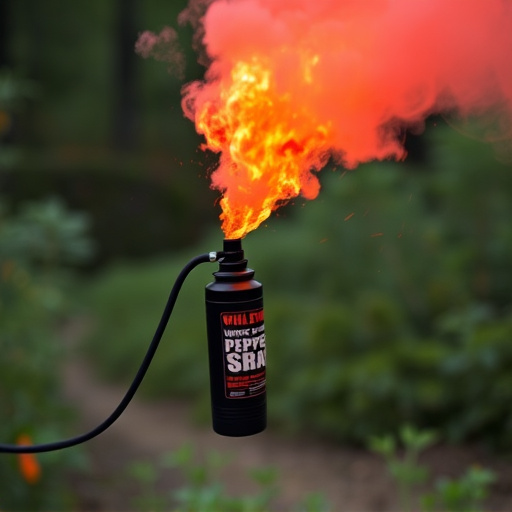Wildfire pepper spray foggers have become essential tools for law enforcement in managing civil unrest and large public events. These devices, featuring capsaicin-based formulas, create irritant clouds to temporarily disable individuals and disperse crowds quickly. Ideal for demonstrations and riots, they offer enhanced accuracy and reduce bystander harm. However, their misuse can pose health risks, necessitating strict protocols, training, and the exploration of alternative tactics to balance public order with minimizing harm, as guided by international regulations.
Riot control agents, a critical component of law enforcement strategy, play a pivotal role in managing civil unrest. This article explores the legal framework surrounding these powerful tools, focusing on understanding riot control agents from a legal perspective. We delve into specific substances like wildfire pepper spray and cutting-edge technologies such as foggers, analyzing their effectiveness and the ethical considerations they raise. International regulations are also scrutinized to provide a comprehensive view of global practices related to riot control agent use.
- Understanding Riot Control Agents: A Legal Perspective
- The Role of Wildfire Pepper Spray in Law Enforcement
- Fogger Technology: Enhancing Tactical Response
- Ethical Considerations and International Regulations
Understanding Riot Control Agents: A Legal Perspective
Riot control agents, including wildfire pepper spray and fogging devices, are powerful tools employed by law enforcement to manage and disperse crowds during civil unrest or large-scale public events. These chemicals are designed to temporarily incapacitate or deter individuals, providing a window of opportunity for police to restore order. However, the legal implications surrounding their use are complex and multifaceted.
From a legal perspective, the deployment of riot control agents must adhere to strict guidelines and regulations to protect both public safety and individual rights. Many countries have enacted laws that specify the circumstances under which these agents can be used, including the type of threats they are intended to counter. For instance, pepper spray is often approved for use against aggressive or violent behavior, while fogging devices might be employed in situations where quick dispersal of a crowd is necessary to prevent property damage or harm to individuals. Law enforcement agencies must balance the need to maintain public order with the potential risks and side effects associated with these agents, ensuring their responsible and proportionate application within the legal framework.
The Role of Wildfire Pepper Spray in Law Enforcement
In modern law enforcement, the use of riot control agents like wildfire pepper spray has become an indispensable tool for maintaining public safety and order during high-tension situations. This potent chemical compound is designed to incapacitate individuals temporarily through irritation and pain, allowing officers to gain control and de-escalate volatile scenarios without resorting to lethal force. The wildfire pepper spray fogger, in particular, stands out for its ability to create a cloud of irritants, effectively neutralizing large crowds or resisting suspects from a distance.
The effectiveness of wildfire pepper spray lies in its quick-acting formula, which includes capsaicin, the primary ingredient responsible for the burning sensation associated with chili peppers. When deployed as a fog, it covers a wide area, making it ideal for crowd control at demonstrations, riots, or mass gatherings. Officers can strategically use these foggers to contain and disperse crowds, providing crucial time for the police to assess and manage the situation. Moreover, modern wildfire pepper spray foggers have evolved to be safer and more user-friendly, with improved accuracy and reduced risk of off-target effects, ensuring law enforcement agents can perform their duties efficiently while minimizing harm to innocent bystanders.
Fogger Technology: Enhancing Tactical Response
Fogger technology has emerged as a game-changer in riot control, offering law enforcement agencies a powerful tool to enhance tactical response during high-risk situations. These advanced devices, such as wildfire pepper spray foggers, are designed to quickly and effectively deploy irritants or chemicals over large areas, making them ideal for crowd control and containing disturbances.
The precision and speed of modern fogger systems allow officers to target specific zones without causing widespread disruption or harm to bystanders. This technology is particularly useful in managing civil unrest, protests, or situations where a large gathering poses a potential threat. With the ability to create a cloud of pepper spray or other agents, foggers provide a strategic advantage, enabling law enforcement to control and disperse crowds swiftly and safely.
Ethical Considerations and International Regulations
The use of riot control agents, such as wildfire pepper spray foggers, raises significant ethical considerations for law enforcement agencies worldwide. These powerful tools can rapidly disperse crowds and disrupt violent gatherings but also carry potential risks to public health and safety if misused or deployed inappropriately. The ethical dilemma lies in balancing the need to maintain public order and protect officers with ensuring minimal harm to protesters and bystanders. International regulations, such as those set by the United Nations, emphasize proportionality, necessity, and legality as key principles when employing force, including chemical agents.
These global standards aim to hold law enforcement accountable for their actions during civil disturbances, promoting transparency and accountability in decision-making processes. The misuse or over-reliance on wildfire pepper spray foggers can lead to adverse health effects, particularly in confined spaces or for vulnerable populations like the elderly and individuals with respiratory conditions. As a result, law enforcement agencies must adhere to strict protocols, receive adequate training, and consider alternative tactics where feasible to avoid unnecessary harm while effectively managing crowds.
Riot control agents, such as wildfire pepper spray and fogger technology, play a pivotal role in law enforcement tactics, offering enhanced safety measures for both officers and citizens. As demonstrated, these tools have evolved to meet the challenges of modern urban environments, with ethical considerations and international regulations ensuring their responsible use. The strategic integration of these technologies, coupled with ongoing legal discussions, promises a balanced approach to maintaining public order while upholding human rights.
